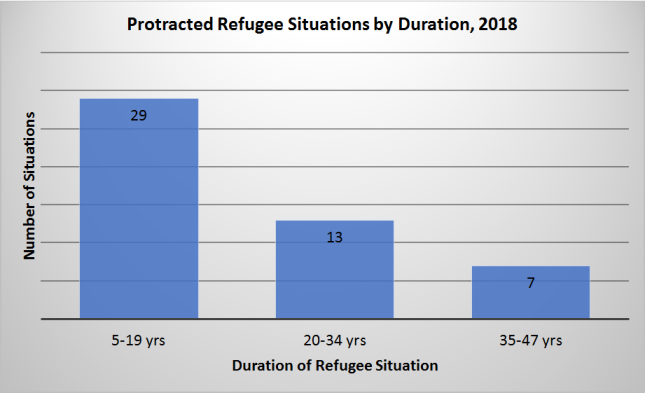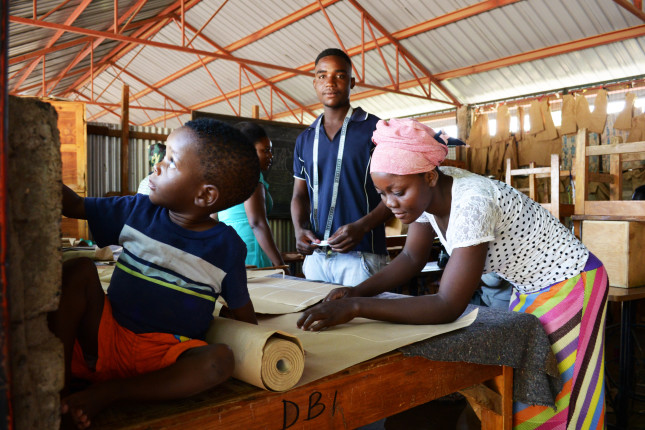-
A Generation in Limbo: Protracted Refugee Situations in Kenya Must Be Addressed
August 15, 2019 By John Thon Majok
The 1951 Refugee Convention spells out refugee rights, including the right to freedom of movement. Yet 68 years later, 15.9 million people are trapped in prolonged exile, living as refugees for anywhere from 5 to 47 years and counting. The unprecedented duration of protracted refugee situations (PRS) and the increasing scale of forced migration demand a comprehensive response beyond humanitarian assistance.
Of the record 70.8 million people displaced by persecution and violence in 2018, more than 25.9 million were refugees, of which 15.9 million were in 49 protracted refugee situations. These figures demonstrate the severity of the crisis within a catastrophe. Failure to address the root causes and mitigate the risks will lead to irregular secondary movement of refugees from poor to rich countries, waste of human potential, and possible radicalization of jobless youth who are stuck in limbo without a future.
After living for more than a decade in limbo in refugee camps in Ethiopia and Kenya, I was one of the lucky few who were given the opportunity to move to America through the U.S. Refugee Resettlement Program. From my viewpoint, refugees are resilient people who need more than just handouts; they want education and job opportunities so that they can become economically self-sufficient. I relate to the issue of protracted refugees as an insider, who was a victim and is a survivor.
Decades of Wasted Human Potential
Protracted refugee situations occur when at least 25,000 refugees from the same nationality have lived in a host country for at least five consecutive years. Despite their implications for security, human rights, resources, governance, peace, and the environment; these extended refugee situations have often been overlooked in the global agenda as deviations from development gains. However, the increasing number and duration makes reducing these long-term refugee situations an imperative. Of the 49 protracted situations in 2018, more than half have lasted between 5 and 19 years and 20 have lasted for 20 to 47 years. The estimated average duration of protracted refugee situations ranges between 18 and 26 years, an alarming number that exceeds the lifespan of a generation.
Protracted refugee situations are both a source and result of fragility, which causes conflict that displaces too many refugees for far too long. Unresolved push factors – persecution, violence, and human rights violations—and a lack of political will in the country of origin cause protracted situations, because refugees cannot safely return home. Moreover, lack of integration policy in a host country denies refugees the rights to work and move freely, hence they are confined in camps. Furthermore, when regional actors fail to enforce peace, conflicts may revive. In South Sudan, a recurrent conflict has exiled more than 2.3 million refugees, making it Africa’s largest refugee crisis.
The future of children born in protracted situations is put on hold, a complete waste of their potential as they are forced to spend the best years of their lives in tattered camps. Suppose prominent former refugees —Albert Einstein, Isabelle Allende, Bob Marley, and others—had been stuck in camps and did not get opportunities to prosper. Would humanity have benefitted from their great minds? Is it in anyone’s interest to allow children to waste their future and become a lost generation? What is the way out of limbo?
Kenyan Refugee Encampment Policy
Kenya has embodied African hospitality for several decades despite its encampment policy. The country used to allow refugees to work and own land, but that policy was overturned in 1991 after the overwhelming inflows of the Lost Boys from Sudan and Somali refugees, among others. Since then, the strategy has been to confine refugees in more remote areas of the country. In 2017, the parliament passed a refugee bill, which the president vetoed and returned to the legislature. In its current form, the refugee bill would give refugees the rights to work and own land. If signed into law, it would mark a significant shift in integration policy by facilitating refugee self-reliance.
As the third largest African refugee-hosting country, Kenya is hosting refugees from at least 19 nationalities. Currently, it confines more than 421,000 refugees in the Dadaab and Kakuma camps. Many of these refugees have lived in legal limbo for 27 years. Despite the numbers, funding to help these refugees is disproportionately low. When the global community is less willing to share responsibility, host states are reluctant to find solutions to protracted situations and they may reduce the protection they offer. Kenya has repeatedly threatened to close Dadaab and expel Somali refugees, citing insecurity and inadequate global attention.
When the duration of refugee stays stretches, donor fatigue sets in, and humanitarian organizations tend to lose interest in funding, forcing refugees to compete with host populations over resources, food, health care, and education services. This leads to a perception of refugees as a burden, though research shows otherwise. In Kakuma camp, refugees face shortage of food and firewood for cooking. In 2018, only 30 percent of refugee households met their energy needs, forcing the remaining 70 percent to gather firewood from the bushes. This has an environmental impact and often caused tension with the host populations whose livelihoods depend on their trees. Searching for firewood is also dangerous. Recently, a torrential rain flooded a nearby river at Kakuma and swept away two refugee girls who were trying to gather firewood.

Way Forward: Can the Global Compact on Refugees Resolve Protracted Situations?
In response to the global refugee crisis, the UN adopted the 2016 New York Declaration for Refugees and Migrants that includes a nonbinding Global Compact on Refugees, which represents the political will of the international community to stand in solidarity with refugees and host countries. The compact aims to ease pressure on host states, enhance refugee self-reliance, expand access to third country solutions, and support conditions in countries of origin—all goals that can be achieved if countries commit themselves.
Graduating protracted refugees from the humanitarian phase requires multisector collaboration involving integration policy, sharing responsibility, and investing in higher education to ensure self-reliance.
Refugee Self-Reliance: The goal of self-reliance should be to reinforce the potential of refugees through development approaches and to nurture their socioeconomic ability to sustainably meet essential needs. Protracted encampment of refugees in a remote region makes self-reliance a necessity. As Elizabeth Ferris argues, “Given the current state of affairs—where solutions are elusive, donor fatigue has set in, and nativist politicians decry the presence of refugees—self-reliance is better than depending on long-term care and maintenance programs.” By shifting efforts from care and maintenance to helping refugees thrive through livelihood initiatives, we can reduce the duration of protracted stays and lessen refugee reliance on aid. However, external support is still necessary during this transition for refugee protection.
In collaboration with the World Bank and other stakeholders, Kenya has taken an encouraging livelihoods approach through the Kalobeyei Integrated Socio-Economic Development Programme. This 15-year plan aims to improve self-reliance of refugees and host Turkana populations by enhancing livelihood opportunities to allow them to maximize their potential. Achieving self-reliance in a legally restricted setting is difficult, and this remains a challenge as Kenyan law does not provide an enabling environment for refugees to prosper.
Integration Policy: Encampment policy restricts refugees to the camps, thwarts economic contributions, and undermines their ability to access opportunities for self-reliance. Providing a legal pathway through integration policy is a win-win solution. One study found that integration reduces the burden of aid, decreases market failures, and incentivizes skills attainment. Full integration is when a refugee is given a legal status that guarantees socioeconomic access and other rights. Kenya should rethink and pass a favorable integration policy that would create an enabling environment for refugees.
Responsibility-Sharing: Resource shortages constrain a host country’s ability to extend socioeconomic rights to refugees. In the spirit of “equitable burden-and responsibility-sharing” where “resources will be made available to countries faced with large-scale refugee situations relative to their capacity, both new and protracted,” as the Global Compact on Refugees states, we can address the situation in several ways. First, give proportionate funding to host countries, such as Kenya, which is facing a 69 percent shortfall of $170.1 million in its refugee budget. Second, give protracted refugees more options by increasing the number of resettlement spaces in third countries. Third, strengthen the capacity of host and destination countries to establish policies that give refugee rights to employment and eventual naturalization. Finally, support development initiatives in countries of origin to address the push factors for a safe return.
Investing in Education: Statistics from UNESCO and UNHCR show that only one percent of refugee youth have access to higher education. This is devastatingly low compared to the 37 percent of world’s youth enrolled in college. But as the UN Secretary General argues, education is one of the ways to resolve global crises because if refugee children are given the opportunity to learn, they will “grow up to contribute both to the societies that host them and to their homelands when peace allows them to return.” Investing in higher education is key because education is a means and an end to refugee empowerment. It bridges the gap between relief and development and ensures refugee potential is not wasted.
The destabilizing effects of protracted refugee situations stretch beyond the region of origin. Resolving them requires collective action and political willpower. By giving refugee-host countries enough funding, providing pathways to refugee integration, increasing spaces for refugee resettlement, and supporting the countries of origin to find durable solutions, we can both ensure refugee self-reliance and lift a generation of refugee children out of protracted limbo.
John Thon Majok is a Senior Program Analyst at the Wilson Center’s Global Risk and Resilience Program.
Sources: Brookings Institution, Business Daily Africa, Institute of Education (University of London), International Rescue Committee, Kenya Law, Overseas Development Institute, “Protracted Refugee Situations: Political, Human Rights, and Security Implications” edited by Gil Loescher et al., Refugee Studies Center (University of Oxford), Refugee Week, The Conversation, The Washington Post, Third World Quarterly, UN, UNESCO, UNHCR, U.S. Department of Health and Human Services, World Bank.
Photo Credit 1: School children in Kakuma refugee camp, Kenya, July 2010. Photo by D. Willetts, courtesy of UNESCO.
Photo Credit 2: Young family practising dressmaking in a vocational training centre in Kakuma refugee camp. Kakuma, Kenya, May 2018. Photo by Adriana Mahdalova.
 A Publication of the Stimson Center.
A Publication of the Stimson Center.

 Source: Author’s graphic using data from
Source: Author’s graphic using data from 


